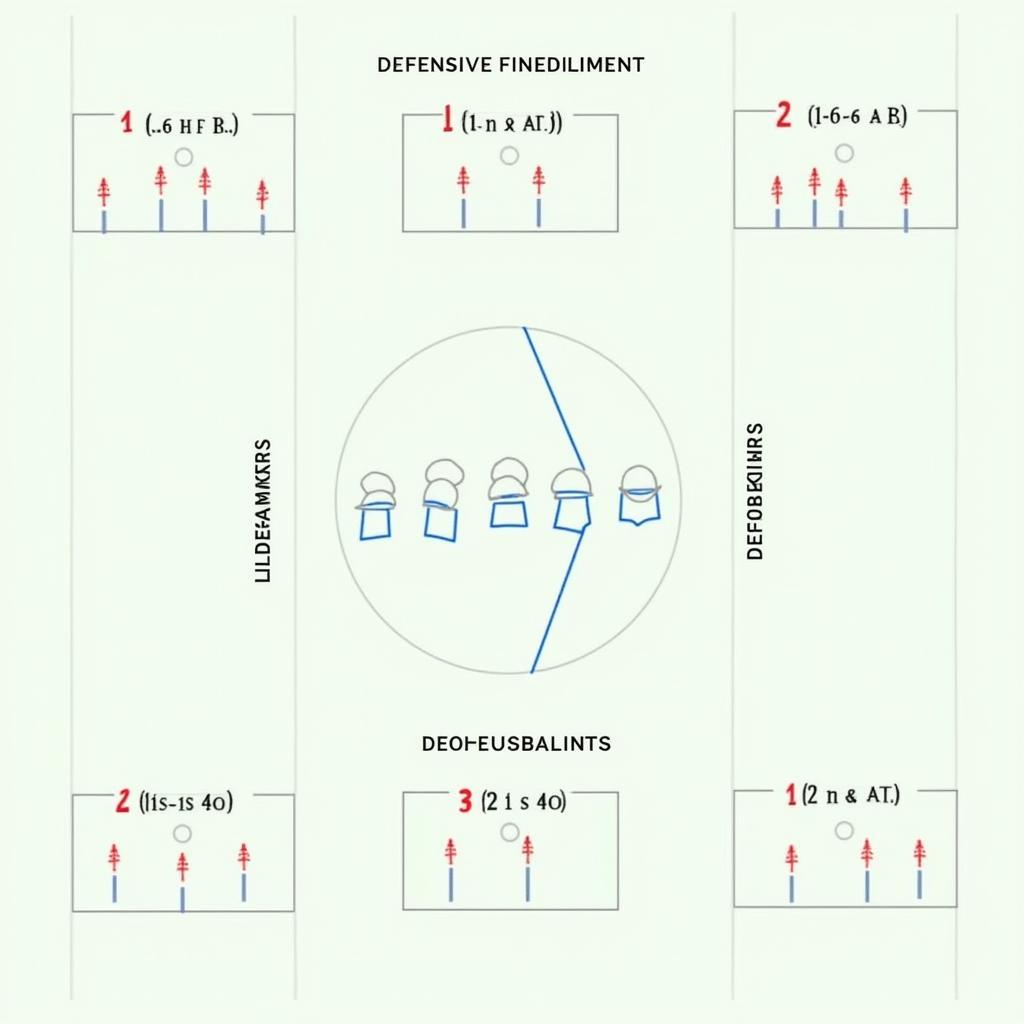Mastering the 6-3 Defense in Football
October 20, 2024The 6-3 Defense is an intriguing and powerful formation in football, known for its flexibility and ability to disrupt offensive game plans. While not as common as other defensive setups, understanding the intricacies of the 6-3 defense can provide valuable insights for both players and fans alike. This article delves into the core principles, advantages, disadvantages, and key considerations when employing this unique defensive strategy.
 6-3 Defense Formation
6-3 Defense Formation
Deconstructing the 6-3 Defense: A Closer Look
At its heart, the 6-3 defense is characterized by its six-man defensive line, a formidable wall designed to overwhelm the offensive line and generate pressure on the quarterback. This setup typically consists of two defensive ends, two defensive tackles, and two defensive ends positioned slightly wider than in traditional formations. Behind this imposing front, three linebackers patrol the middle of the field, responsible for plugging gaps, covering short passing routes, and pursuing ball carriers. The secondary, often referred to as the defensive backs, comprises two safeties and two cornerbacks, tasked with defending against deep passes and containing the edges of the field.
Advantages of the 6-3 Defense: Unleashing Defensive Power
One of the most significant advantages of the 6-3 defense lies in its ability to create confusion and uncertainty for the offense. The sheer number of defensive linemen can make it challenging for the offensive line to identify blocking assignments, potentially leading to free rushers and sacks. Moreover, the 6-3 defense allows for a high degree of blitzing flexibility, with various combinations of linemen and linebackers able to surge towards the quarterback. This aggressive approach can disrupt the timing of passing plays and force hurried throws, increasing the likelihood of turnovers.
 6-3 Defense Blitz Packages
6-3 Defense Blitz Packages
Another notable strength of the 6-3 defense is its effectiveness against the run. The six-man defensive line creates a formidable barrier that can be challenging for running backs to penetrate. Additionally, the presence of three linebackers behind the line of scrimmage provides added support in stopping the run. These linebackers can quickly flow to the ball carrier, limiting yards after contact and minimizing the effectiveness of rushing plays.
Disadvantages of the 6-3 Defense: Navigating the Challenges
While the 6-3 defense presents several advantages, it also has certain drawbacks that coaches and players must consider. One primary concern is its vulnerability to pass-heavy offenses. With only two safeties and two cornerbacks, the 6-3 defense can be susceptible to deep passing plays, especially if the opposing team has talented wide receivers who can win one-on-one matchups. To counter this, defensive coordinators often employ zone coverage schemes, aiming to provide safety help over the top while limiting big plays.
Another potential challenge for the 6-3 defense is the physical demands it places on the defensive linemen. Maintaining a low pad level and engaging in constant hand-to-hand combat with offensive linemen requires a high level of strength, stamina, and technique. If the defensive linemen tire out, their effectiveness in both rushing the passer and defending the run can diminish.
Situational Applications of the 6-3 Defense: Adapting to the Game
The 6-3 defense is most effective in specific game situations, often dictated by down and distance, field position, and the opponent’s offensive tendencies. For instance, it can be a potent weapon on obvious passing downs, such as third-and-long, where the defense can prioritize rushing the passer and forcing the quarterback into making a quick decision.
Conversely, the 6-3 defense might be less suitable in short-yardage or goal-line situations, where the offense is more likely to run the ball. In such scenarios, the defense needs to be stout at the point of attack, and having fewer defensive linemen could create vulnerabilities that the offense can exploit.
Coaching and Player Considerations: Implementing the 6-3 Defense
Successfully implementing the 6-3 defense necessitates careful coaching and a specific type of player. Defensive linemen in this system need to be strong, agile, and technically sound to succeed in both pass rushing and run defense. They must possess a relentless motor and the ability to disengage from blocks effectively. Linebackers, on the other hand, should be athletic and possess excellent instincts, enabling them to diagnose plays quickly and react accordingly.
 Football Coach Explaining Plays
Football Coach Explaining Plays
Communication is paramount in the 6-3 defense. With so many moving parts and potential blitzes, players need to be on the same page pre-snap and adjust their assignments based on the offensive formation and any shifts or motions. Clear communication ensures that everyone understands their responsibilities, minimizing confusion and maximizing the effectiveness of the defense.
Conclusion: Embracing the Complexity of the 6-3 Defense
The 6-3 defense is a fascinating and multifaceted defensive strategy that can be highly effective when executed properly. Its ability to create pressure on the quarterback, disrupt offensive game plans, and force turnovers makes it a valuable tool for any defensive coordinator willing to embrace its complexities. While not without its challenges, understanding the nuances of the 6-3 defense can deepen your appreciation for the strategic depth of football.
Need help? Contact us!
Phone Number: 0915117113
Email: [email protected]
Address: To 3 Kp Binh An, Phu Thuong, Viet Nam, Binh Phuoc 830000, Vietnam.
We have a 24/7 customer support team.